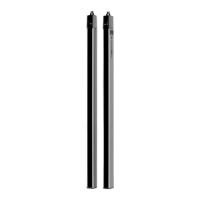Mounting
Leuze electronic MLC 510 27
In addition to design characteristics, the safety sensor offers functions that can remedy this:
• Selectable transmission channels (see chapter 4.1 "Transmission channel changeover")
• Range reduction (see chapter 4.2 "Operating range selection")
• Also: opposite mounting
6.2 Mounting the safety sensor
Proceed as follows:
• Select the type of fastening, e.g. sliding blocks (see chapter 6.2.3 "Fastening via BT-NC60 sliding
blocks").
• Have a suitable tool at hand and mount the safety sensor in accordance with the notices regarding the
mounting locations (see chapter 6.2.1 "Suitable mounting locations").
• If possible, affix safety notice stickers on the mounted safety sensor or device column (included in de-
livery contents).
After mounting, you can electrically connect (see chapter 7 "Electrical connection"), start up, align (see
chapter 8 "Starting up the device"), and test (see chapter 9.1 "Before commissioning and following modifi-
cations") the safety sensor.
6.2.1
Suitable mounting locations
Area of application: Mounting
Tester: Technician who mounts the safety sensor
Tab.6.3: Checklist for mounting preparations
Check: Yes No
Do the protective field height and dimensions satisfy the requirements of ISO13855?
Is the safety distance to the point of operation maintained (see chapter 6.1.1 "Calculation
of safety distanceS")?
Is the minimum distance to reflective surfaces maintained (see chapter 6.1.4 "Minimum
distance to reflective surfaces")?
Is it impossible for safety sensors that are mounted next to one another to mutually inter-
fere with one another (see chapter 6.1.5 "Preventing mutual interference between adjacent
devices")?
Can the point of operation or the danger zone only be accessed through the protective
field?
Has bypassing the protective field by crawling under, reaching over, or jumping over been
prevented or has corresponding additional distanceC
RO
in accordance with ISO13855
been observed?
Is stepping behind the protective device prevented or is mechanical protection available?
Do the transmitter and receiver connections point in the same direction?
Can the transmitter and receiver be fastened in such a way that they cannot be moved
and turned?
Is the safety sensor accessible for testing and replacing?
Is it impossible to actuate the reset button from within the danger zone?
Can the entire danger zone be seen from the installation site of the reset button?
Can reflection caused by the installation site be ruled out?
NOTICE
If you answer one of the items on the checklist above with no, the mounting location must be
changed.

